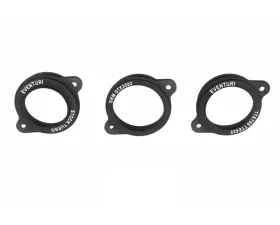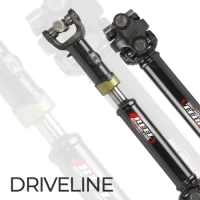Turbo Flanges
Filters
Universal Parts
Price range

034 Motorsports Drain Flange 2.7T Oil Pan to -10AN Large 24mm Audi S4 | RS4 | A6 | Allroad 1998-2004

Eventuri Turbo Inlet SRM GTX Turbo Flange Audi RS3 8V Gen 2 | TTRS 8S
VRNR4T5

Eventuri Turbo Inlet Stock Turbo Flange Audi RS3 8V Gen 2 | TTRS 8S
VRNR4T5

Eventuri Turbo Inlet TTE700/625 Turbo Flange Audi RS3 8V Gen 2 | TTRS 8S
VRNR4T5

What is a Turbo Flange and what does it do?
Turbos are often referred to by "T" numbers that are really a turbo’s class type. These numbers were originally created by Garrett, the largest turbo manufacturer in the world. You have probably heard people talking about T3 and T4 turbos in their car. The “T3” number is a general CFM classification. The T number also specifies a compatible exhaust flange type which the turbo will bolt onto.
It’s important to understand there are many different types of T3 turbos with different air outputs which are rated for different horsepower applications. So when somebody says they have a T3, they are actually saying what class of turbo they have, and the flange type. Generally speaking, T3 class turbos can deliver enough air volume for applications in the 200 to 300HP range.
But what has T3 and T4 class turbos have to do with the turbo flange? Well, aside from both having the word “turbo”, turbo flanges are pieces of metal that have been machined to connect a turbocharger to an intake or exhaust system. Commonly made of mild steel or stainless steel, a turbo flange can also be manufactured from aluminum. Depending on the particular application, there are several different types and styles of turbo flange designs that work on a vast array of turbocharger sizes and ports. Most flanges are produced on a computer numerical controlled (CNC) machine or on a flame cutter. Some high-performance, specialty pieces are created from a solid chunk of billet material on a milling machine, however.
Because the turbocharger isn’t connected to the engine directly like a cylinder head, the turbo flange connects to the turbocharger in one of several ways, as well as to the exhaust and intake pipes through the use of flanges. Each flange, regardless of its function or application, also commonly uses a flange gasket. The gasket is sandwiched between the flange and the turbocharger housing.
The mounting surface of a turbo flange must be extremely flat and finished to a proper tooth so that it might bite into the gasket material properly. This is critical due to the tremendous amounts of boost pressure that can be generated by the spinning turbocharger. The smallest imperfection in the flange or its adjoining, mating surface could result in a loss of pressure. This translates to less power that you thought you are producing.
More important than the power, though, this might lead to the destruction of other critical engine components, such as pistons, cylinder walls and valves. Other types of damage that could potentially result from a damaged or blown turbo flange are oil leaks, lack of oil pressure to the turbocharger bearings and heat damage to the turbo from misdirected exhaust gasses. Yikes!
Vivid Racing carries high performance turbo flanges from top manufacturers to make sure that you are always making the power you want. The exact fitments will also ensure the safe operation and longevity of your engine.
Don’t know what you’re looking for? Give one of our world-class professionals a call at 1-480-966-3040.

.jpeg?q=90&p=thumb&w=200&h=200)











.jpeg?q=90&p=thumb&w=40&h=40) Brakes
Brakes  Driveline
Driveline  Electronics
Electronics  Handlebars & Controls
Handlebars & Controls  Package Deals
Package Deals  Wheel Accessories
Wheel Accessories  Wheels by Vehicle
Wheels by Vehicle  Tools and Maintenance
Tools and Maintenance  Universal & Repair
Universal & Repair  Vivid Racing Gear
Vivid Racing Gear 











